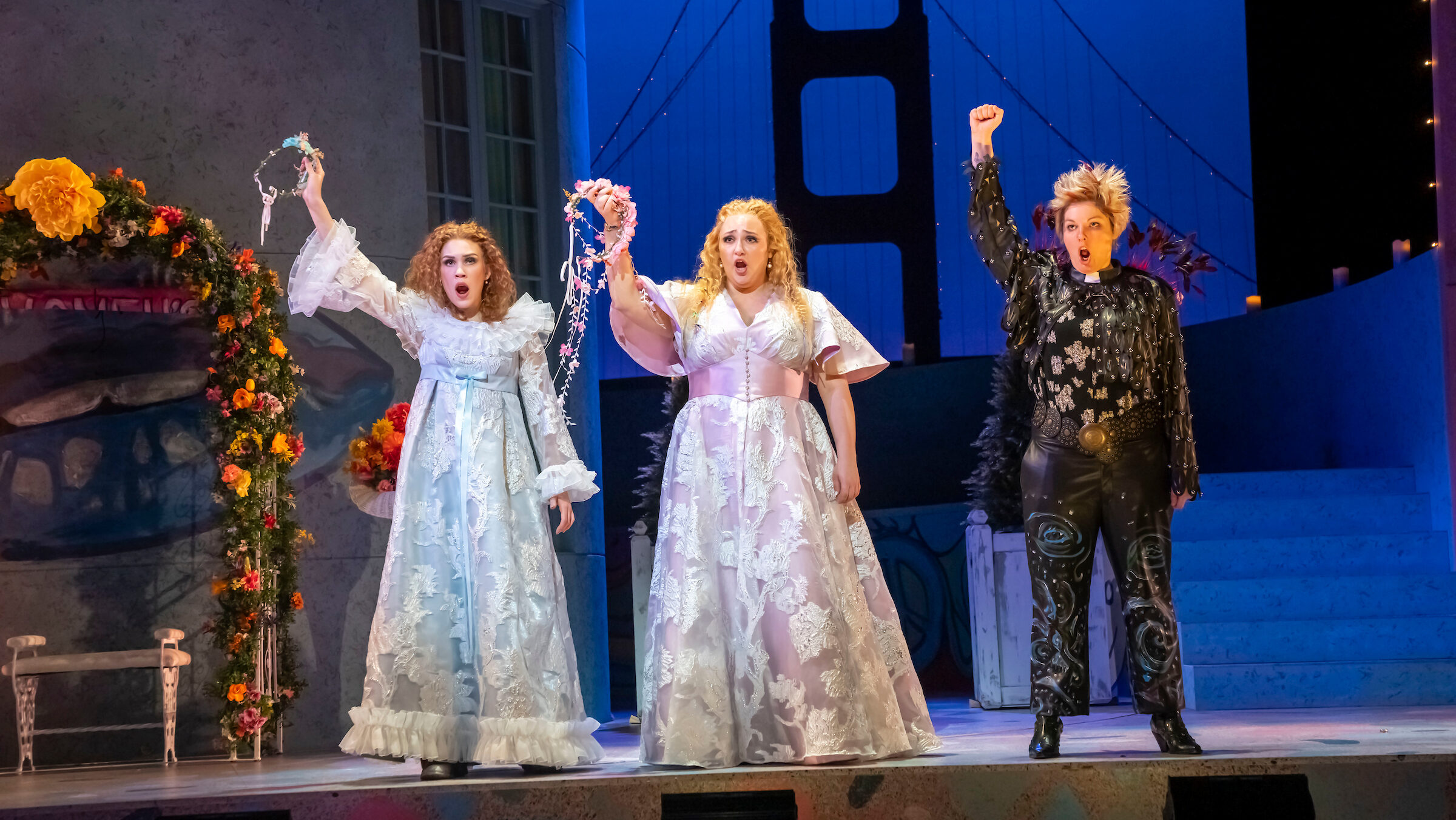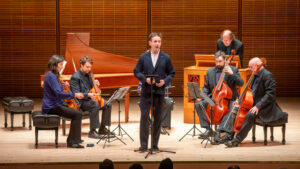

In case you were not aware, Huguet’s creation itself was an important milestone, as it was commissioned to commemorate Vienna State Opera’s 150th anniversary when it opened with star-studded cast last May, many of which returned for this revival.
My colleague Christian Ocier wrote a fascinating and elaborately detailed review of the first run–an essential read for his insights into the production and particularly the star-studded cast – so I would focus more on the artists new to this revival and other production matters specific to that day.
Before we begin, perhaps it is worthwhile to look back at the long history of Die Frau ohne Schatten at Vienna State Opera. The company presented eight new productions over 100 years, starting with the premiere on October 10, 1919 under Franz Schalk with the top stars of the House at that time; Karl Aagard Østvig and Maria Jeritza as the Emperor and Empress, Richard Mayr and Lotte Lehmann as the Dyer and his wife, and Lucie Weidt as the Nurse completed the cast. That production run pretty much for every year for the next ten years, in a total of 39 shows.
Three years later, Lehmann returned as the Dyer’s wife in a new production conducted by Clemens Krauss alongside Josef Kalenberg, Viorica Ursuleac, Gertrude Rünger and Josef von Manowarda.
The great Strauss conductor and his close friend Karl Böhm led the next new production right smack in the middle of World War II in 1943, with Torsten Ralf, Hilde Konetzni, Elisabeth Höngen, Josef Herrmann and Else Schulz.
Twelve years later, as part of the Vienna State Opera reopening celebration, Böhm was back in the podium with one of the greatest Die Kaiserins ever, Leonie Rysanek, alongside Hans Hopf, Elisabeth Höngen, Ludwig Weber, and Christel Goltz, in a production by Rudolf Hartmann. A recording of this was released by Orfeo; and that same year Böhm recorded his famous Decca studio recording with the same forces, albeit with Vienna Philharmonic and Paul Schöffler as Barak.
The occasion of Richard Strauss’ 100th birthday (June 11, 1964) saw a brand new mounting staged and conducted by Herbert von Karajan assembling luxurious cast including Jess Thomas, Rysanek, Grace Hoffman, Walter Berry and Christa Ludwig, with Lucia Popp and Fritz Wunderlich in minor roles! DG released a recording of this event.
Incidentally, two years later Böhm led a similar cast (Rysanek, Berry and Ludwig) through Nathaniel Merrill’s staging for the Met premiere, one of the first successes in the Lincoln Center location.
Böhm returned one more time, 34 years after the wartime show, to headline what was arguably the most successful staging Die Frau ohne Schatten in Vienna – that of Helge Thoma – again with Rysanek and Berry, plus Matti Kastu, Ruth Hesse and the formidable Färberin in Birgit Nilsson; this went on for 40 performances over 15-year period.
The first revival of that production in the fall of the same year landed on another recording, this time for DG, with the same cast as the premiere, except for James King as Kaiser instead. The last new production in Vienna was 20 years ago, when Giuseppe Sinopoli rounded up Johan Botha, Deborah Voigt, Marjana Lipovšek, Falk Struckmann and Gabriele Schnaut in Robert Carsen’s mounting.
A sense of celebration was definitely in the air last Thursday, as prior to the performance Vienna State Opera director Dominique Meyer gave a lengthy speech detailing the significance of that day – including some of the history above – and presenting conductor Christian Thielemann with a copy of the premiere score of Die Frau ohne Schatten. (Please correct me if I was mistaken here as I don’t understand German!)
Like Ocier, the greatest element of the performance that day to me was indeed the majestic conducting of Thielemann leading the Staatsoper in a reading that fully realized the complexity and colorfulness of the score. The climaxes were powerful and shapely, the many chamber-like moments were in turn delicate and mesmerizing, and there was a sense of pressing urgency that made the whole performance truly engrossing. I particularly loved the Orchestral Interlude in Act 2 with its very vivid rendition of the Falcon calls by the flute; it almost felt that there was one flying above me!
To my ears, surprising as it might sound, Thielemann’s craft seemed to be forward-looking; in his hands Strauss’ dense scoring and his stretch of tonality anticipated the Second Viennese School much more than full-blown Romanticism. As I sat third row behind him, I was able to observe how his calm and elegant gestures (compared to, say, Kirill Petrenko) were able to generate the loudest noises from the orchestra; it was all truly fascinating!
Polish bass-baritone Tomasz Konieczny, whom Ocier interviewed here,a newcomer to this revival, made a scene-stealing turn as Barak the Dyer. Konieczny was no stranger to the role, having sang it in the Guy Joosten mounting for Deutsche Oper am Rhein in 2008 and its subsequent revivals. Here his voice sounded warm and round, and even more winning was his interpretation of the role. For a singer acclaimed for his Alberich,
Konieczny turned a surprisingly tender and caring take as the family man longing for children. His scenes where he tucked his wife to sleep (even after she rejected him) or with his brothers and the beggar children were absolutely moving and joyful. His Barak was almost too saintly, albeit still human, as evident when Konieczny flashed his Alberich rage in the end of Act 2, after Barak found out that his wife had no shadow!
So wholesome was Konieczny’s Barak that it had unintended consequence to me, namely my slight disappointment with Nina Stemme’s Färberin. It pained me to say this as she was one of the main reasons for me to make the trek here to see the show.
Not content with merely playing the overbearing wife, she upped the ante and stretched the interpretation so far that it felt as if Barak married Elektra (Elektra had reason to kill, Färberin did not!) There was so much hardness in the reading that I felt rather unnecessary, and when she threw blank stares, she looked more like deranged psychopath.
I even thought (I’m aware I might be alone in this) that her steely voice might be affected by that, as while it was still powerful and impressive (particularly in arduous Act 2), it lacked some warmth and color I usually associated with her. She backed down for the last act, but by then it was too little too late. Nevertheless, her duet with Konieczny towards the end was stirring and beautifully performed, it redeemed the performance somewhat.
The other fresh face to this production was the villainous Nurse, sang by Mihoko Fujimura, who made role debut. While she sang earnestly, unfortunately her voice sounded very underpowered especially in the lower register and she lacked presence as the evil masterplan. Her big scene in Act 3 leading to the Nurse’s banishment came and went without much impact.
I was pleasantly surprised with Camilla Nylund’s Kaiserin that perfectly negotiated the demands of the score. Her entrance aria “Ist mein Liebster dahin” delivered with clarity and bell-like lyrical voice, as if matching the white dress she was wearing, and after she came down to the human world and traded the color to bright red, the voice significantly turned dramatic and much weightier.
In this staging Huguet set the story almost from Kaiserin’s perspective; that red dress that she wore was focal point in every scene she appeared, and Nylund completely commanded the stage in that manner. Not even three loud thuds resulting from the failure of the stage screen to lift up bothered her during her long soliloquy scene in Act 3!
After much hoopla for Andreas Schager’s role debut as Kaiser on this auspicious day (he was my other main reason for attending the show) you could imagine my disappointment not to see his name on the board when I got to the Vienna Opera House (His cancellation was announced two days prior!)
Luckily, Stephen Gould, who assumed the role during the first run, was in town for Ariadne auf Naxos, and he did perform Kaiser that night with ease and power, sounding both heroic and noble in his delivery. I thought it was worth to point out that he sang Kaiser and Bachus, two of Strauss’ toughest tenor roles, in subsequent nights as the result of this substitution! A truly commendable achievement for the American heldentenor!
Clemens Unterreiner rounded up the new cast with his dignified performance as Geisterbote.
Many had been said about Huguet’s production; they mostly revolved around the words “safe” and “traditional”, and I thought there were a lot of truth in those criticism. I particularly loved the use of specific colors to characterize the leading roles in Clémence Pernoud’s costumes; the aforementioned red for Kaiserin, noble green for Kaiser, blue for both Barak and his wife (the color turned to gold when the Färberin was under temptation), and obviously, black was the only color appropriate for the Nurse.
Aurélie Maestre’s set design was evocative in conjuring up images of mythical fantasy land where Strauss and Hofmannsthal set the story upon with Oriental flavor; the pavilion in the beginning and the rock wall formation of Keikobad’s Temple looked like they were lifted straight up from Chinese paintings. Equally dreamy was the arrival of the Empress and the Nurse to that temple via a boat with single lantern, reminiscent of similar scene from The Phantom of the Opera!
However, despite such pretty backdrops, Huguet seemed to be reluctant to embrace the magical aspects of the story and resolved to strip out pretty much actions related to them, resulting in occasionally inconsistent dramaturgy. For example, while the Nurse didn’t do any magic earlier in Barak’s place, she was shown to be casting a spell that transformed Barak’s hut into glowing lava at the end of Act 2!
Even more puzzling was his decision to infuse a secondary storyline – the visions of war – in the already complicated tableau, substituting Kaiser’s hunting lodge scene in Act 2 with remnants of war, with Kaiserin was seen to be helping a young wounded soldier. Barak and his wife also separately ended up with displaced people in the beginning of Act 3. Although it had been suggested that this was representative of the trouble times of the genesis of the opera, I thought that it could also depict the trying times during its history above.
Nonetheless, the juxtaposition of the mythical world and the gloomy aftermath of war oftentimes threatened to confuse the audience unfortunately. It certainly had the effect of weakening the narrative. Equally damaging was some of the staging quirks such as the full-frontal nudity of the man that the Nurse conjured for the Dyer’s wife; it felt so gratuitous given the seriousness surrounding that scene!
If these all were sounding like a lot of nitpicks, it was because I held this cast and the production team in the highest regards, given the pedigrees of everyone involved. Don’t get me wrong, this was still one hell of a show, albeit imperfect, and kudos to Vienna State Opera for celebrating it in such a grand way.

























Comments